August 7, 1967 – Battle of Ni Binh

August 7, 1967 was a monumental day for me. I had been “in country” for less than 30 days and had not yet been into a “hot” LZ under enemy fire. This day would change that and change it drastically. Posted here are stories of my day, as well as stories from others who participated in that eventual day. The originals are posted on the Blackhawk/Crusader web site http://www.187thahc.net
Others have written about this day in other places on the 187th Net. Check out the after action report on the Crusader page, this has some actual details. I am still trying to write mine from a memory fogged over by 30 years of trying only to remember the good things. What I write here is what I remember seeing and feeling that day.
At 1200 hours, 7 August 1967, the 187th Assault Helicopter Company was released by the 4th Battalion, 9th Infantry, 25th Infantry Division after conducting combat assaults. The company was to assume II FF Ready Reaction Force. On departing Fire Support Base Martha, the Air Mission Commander, Blackhawk 6, was notified by radio that he and his company were to report to the 4th Battalion, 12th Infantry, 199th Light Infantry Brigade. Blackhawk 6 reported to Thu Douc at 1230 hours to receive a briefing by a representative of the Battalion’s S-3 section. During this briefing, the concept of operation was explained, the locations of the pickup and landing zones given, and the estimate of one possible VC squad in the area was given. Blackhawk 6 asked about suppression and was told that there would be no preparation or suppression because friendlies were assumed to be there. Blackhawk 6 then went to the PZ to await the arrival of the rest of the company which landed at approximately 1300 hours. He then briefed the platoon leaders of the two airlift platoons and the gun platoon before returning to Thu Douc to pick up the command and control party, When they were aboard his aircraft, he took off, headed for the LZ, and called the lift ships out of the PZ.
Enroute to the LZ, the gun platoon leader, Rat Pack 6, Called Blackhawk 6 to inform him that there were numerous people on the ground near the LZ and that he saw numerous sampans loaded with people. Rat Pack 6 was approximately two minutes ahead of the C&C ship at this time. Blackhawk 6 then reported these observations to the Air Mobile Force Commander, Valiant Knight 6, said that there was no restriction on the civilians in the area from using the canals and that the people were probably friendlies. Valiant Knight 6 again specified that there would be no preparation or suppression. Rat Pack 6 had made a low pass over the area in the meantime and had observed people in camouflaged uniforms. He then asked Blackhawk 6 if there were ARVN’s in the area. This was relayed to Valiant Knight 6, but no answer was received from him. At this time eight lift ships were on one-half mile final to the LZ. Blackhawk 6 then reminded the flight to have visors down, harness locked, and to use negative suppression unless fired upon.
On very short final, chalk two (AC WO James R. Conde, PP Robert J. McMorine) reported, “Chalk two, receiving fire from three o’clock.” Almost simultaneously, all the aircraft reported receiving fire from all directions. The Rat Pack was on position to cover the flight and immediately began to fire rockets, mini guns , and 40 mm grenades into the area along the north and south side of the LZ. The lead helicopter began to depart the area immediately after letting off the troops. Chalks two and Four (AC WO Robert W. Seay, PP WO Samuel E. Jones) did not land but aborted with wounded aboard and went to Hotel 3. As the flight was departing the LZ, Chalk six, LT. Connelly, in aircraft 66-934, reported that his aircraft was badly hit and that he would have to land , then, almost immediately, he reported engine failure and entered autorotation at which time he also suffered the loss of hydraulics, His autorotation was successful into the nearest open area. Chalk seven , LT. Eshelman, followed his ship down and evacuated the crew, weapons, and radios. (See more about the First Rescue here) Chalk seven had been unable to land in the LZ, so he left his seven troops as a security force. However, in his rush to help get the crew out of the downed ship, one US enlisted man from the seven aboard LT. Eshelman’s ship was hit on the head by the still turning rotor blade of 66-934. He was evacuated along with the downed crew and the mortally wounded infantry company commander. Thus, Chalks one, three, five, six, and eight landed in the LZ and unloaded troops. Chalk Two, aircraft 66-854, had diverted to Hotel 3 with the pilot wounded in the elbow followed by Chalk four, aircraft 66-922, with two wounded infantry men aboard and numerous bullet holes in the ship. Chalk seven had departed for the 24th Surgical Hospital with five wounded aboard. Chalks one, three, five, and eight returned to the PZ. All eight aircraft had received hits but had remained in the LZ long enough to evacuate the wounded from the first lift. Chalk eight shut down in the PZ to assess damage. At this time , a message was received at Tay Ninh that aircraft were hit, aircrews were wounded, and more lift ships would be needed. The last remaining flyable aircraft was immediately dispatched to the operational area.
Capt. Presson was then directed by Blackhawk 6 to bring in the second lift and that no fire was being received in the LZ. The second flight brought in along a route further south than the original route, but the LZ was the same. Again, on short final, all ships were suppressing along the right side of the formation. All four helicopters were hit, but no crew members received wounds. As the flight came out of the LZ, Chalk 4, Capt. Wagner in ship 66-932, reported that he was losing power. He set his aircraft down approximately 1000 meters southwest of the LZ. Chalk 1, Capt. Presson, went down with him to extract the crew, weapons, and radios. As he neared touchdown his ship’s tail rotor drive shaft was severed by automatic weapons fire from the left. The aircraft, 66-819, spun to the right and crash landed, but no personnel were injured. Chalk Two, WO Britt, then came in to extract the crews, radios and weapons of both downed ships. In the meantime, Chalk three, aircraft 64-13817, was hit again coming out of the LZ, Chalk 3 (AC WO Wayne R. Coe PP WO David Webster), lost the complete tail rotor and cyclic control, the ship spun violently toward the ground. WO Coe, the Aircraft Commander, rolled off the throttle and lowered pitch. This action slowed the spin. At the last minute, he rolled on throttle and pulled pitch. This action slowed the spin and cushioned the impact. Three crew members were injured but not seriously. The fourth was unscratched. This crew was evacuated by an aircraft from the 118th AHC, Thunderbirds, whose crew had witnessed the crash. Aircraft 64-131817 had been shot down by 50 caliber fire and was totally destroyed by fire.
At this time, Blackhawk 6 received a report that an aircraft from the 68th AHC Top Tigers had been hit and had been destroyed in the LZ. He turned back to the LZ to see what had happened as the Top Tiger Ship had not called the C&C ship before entering the LZ. He apparently had been cleared by someone on the ground and had been informed that the area was secure. His approach terminated within fifty meters of an automatic weapons position. The enemy gunners waited until the ship was very close to termination and then raked the cockpit with fire killing one aviator.
My comments: After we dropped our downed crews off at the 24th Evac in Bien Hoa, we returned to the PZ to see what was up. Well not much was, when we got there I think there were 2 or three other birds left flyable. A Tac ‘E’ or Tactical Emergency had been called, that meant that every available aircraft in the area would be converging on this spot shortly. Already, extra guns were coming in and reporting to Rat6.
We shut down to check for damage. We had been very fortunate, took only a couple of rounds, unfortunately one had clipped our engine ignition wires. This wire carries a lot of voltage to the engine igniters during start to get the fire going and is heavily shielded. The CE repaired it the best he could and we decided to try a start. We got the aircraft started and figured we would need to keep it running from now on or leave it where we shut it down.
As explained by the After Action report, Blackhawk crews and aircraft were down everywhere, so we got back into the air to see if we could help. 1LT Charles Eshelman the A/C reported to Blackhawk 6 and asked for instructions.
Just prior to our getting airborne, the Top Tiger aircraft mentioned above had attempted to land in the LZ and was decimated by small arms fire. Reports varied but at least one crew member was dead and others wounded. He had been told by the ground forces that they were receiving no fire, which was true, the enemy was waiting for more aircraft, they were much easier targets.
As we got airborne we were able to listen to the rescue attempts to get the Top Tiger crew out. I am not sure I have the order correct, but there were at least 3 attempts to get the crew out, all unsuccessful. I remember thinking “those guys have got to have big balls, everything that gets close is hit and crews are wounded”. Little did I imagine what was coming.
The first attempt was Smoky, our battalion smoke ship. A smoke ship injects oil into the exhaust to produce a heavy smoke screen between the tree line and the landing aircraft. It’s great and most slick pilots love it. I have never been hit when Smoky was along. Shot at yes, hit no. Anyway, Smokey made the first attempt and on short final the LZ erupted. Smokey’s CE was wounded and he had to abort and head for the 3rd Evac in Saigon.
Next was a Razorback gunship. As I was to learn later this wasn’t a good idea in its own right. Gunships are typically heavy and have a hard time taking off on a runway, much less a hot LZ. But the Razorback crew as low on ammo and fuel and decided to try. On short final he was plummeted by small arms fire, his CE was wounded in the neck and a rocket pod was hit and caught on fire. He tried to jettison, but it hung and the other CE had to kick it off. He headed to 3rd Evac, Saigon.
From the After Action Report: The gun teams immediately hit the north side of the LZ. Initially, we heard that one of the Top Tiger crewmen was wounded and that three were killed. This was later revised to one WIA, one KIA, and two uninjured. The Black Baron smoke ship, Smoky, flown by Capt. Kambrod, volunteered to try to pick up the wounded crew member. As Smoky approached the LZ, he was hit by intense automatic weapons fire and both the gunner and crew chief were wounded in spite of gunship cover. He departed the area to get medical treatment for his wounded. Razorback 35 Capt. Conner, then tried to get in to the LZ while being covered by Razorback 36. He received intense automatic weapons fire and his gunner was hit in the neck. His ship was badly hit and the right rocket pod began to burn. The aircraft commander then jettisoned his rocket pods and departed the LZ to the north. Blackhawk 6 told him to turn left away from the heavy fire, which he did. Razorback 35 then made a forced landing near a Popular Forces Camp near the LZ at coordinates XT 801061. Blackhawk 2 who had volunteered to go into the LZ if needed, followed Razorback 35 down and evacuated the crew chief to the 12th Evacuation Hospital at Cu Chi.
My comments: Now the CO of the 199th, a 1 star (BG) decides they can make an attempt. They are low on fuel and need to go back and refuel, so one more try to get the crew out first. He has an aircraft full of staff monitoring the battle. So in they go, or almost… On short final the VC rake the aircraft, the General and one aide are wounded, they abort and head for the hospital… this is starting to get real serious. I think they also went in without permission from Blackhawk 6 the air mission commander. I know he was steamed on the radio.
About now, Blackhawk 6 orders everyone else to stay out of the LZ, no more attempts. You have to understand how hard this is, for one aviator to leave others behind in an LZ. Also, we have been listening to all this on the radio and actually got to see the Razorback attempt from high above.
Well about this time Eshelmann comes on the intercom and lets us know he thinks he can get into the LZ. He has been watching and has a plan to keep us out of the firing line until we are in the LZ, with a quick pickup, we could be out before they had time to get a bead on us. He isn’t going to volunteer unless the crew agrees. So we take a vote. The two crewmembers say go, they’re even upbeat about it. To be honest if one of them had of said NO, I probably would have joined him, but since I would have been the lone NO, I agreed also.
So Eschelman calls Blackhawk 6 and starts discussing the plan. BH 6 isn’t in favor of risking another crew, but Eshelman does have a good plan. Low level down the river, Rat6 suppress the area heavily in coordination with our approach. They should be hitting the tree line while we are on short final. This will keep the bad guys down and we have a better chance of getting in. Pop up over the LZ, drop it in, pick up the crew, and de de outta there. A good simple plan. BH 6 agrees to allow the try and so we all got ready. Eshelman wasn’t a big talker, he was a quiet guy and continued to be a quiet guy for the remainder of his tour. He assigned me the job of monitoring the radio. I was to coordinate with crew and the ground guys.
I don’t remember much about the approach to the LZ. I was monitoring the radio for reports on the enemy and BH6 was calling out our progress so he could coordinate the prep and covering fire. I do remember the pop up into the LZ, the short final, landing, and departure. Since I wasn’t flying, I had a lot of free time on my hands, in between yelling over the radio and at the ground guys to load the wounded crew, I got to look around a lot. These were the longest minutes of my life, 30-60 seconds on short final, few minutes in the LZ (seemed like an hour), and a minute or two to clear the LZ and the fire. These are minutes that are etched in my mind, the images and details of each second and sub-second will always be there.
As I said before, we came in low level and flared just after clearing the tree line, Rat6 and his gun escort had been prepping the LZ prior to us and continued to hit them while we were in the LZ, although he warned us they were running low on ammo, so hurry…
We started receiving heavy fire as soon as we cleared the tree line around the LZ, we were in a flare to lose airspeed and so most of the hits were in the belly. As we dropped into the LZ we could see people scurrying everywhere, good guys and bad guys, it was a sight. The enemy were concentrating fire on the crew, since they were the ones causing the most casualties. Most of the fire and return fire was on our final approach, but it was continuous and loud. As soon as we flared we started taking small arms fire. You could feel it hit the ship, I swear if you hit a UH-1 with a BB gun, you could feel it, every single round. Eshelman was flying and I was following on the controls, SOP for a hot LZ. He shouted at Peniska (the gunner, on my side) that there was enemy running around on that side of the aircraft. I took a look out the the cargo door (I said I was green) and could see people in uniforms and with packs running from the tree line. Peniska was firing his M-60 with one hand and his M-16 with the other (TINS, I swear to God) and you could see them going down, I don’t know if it was from being hit or just to find cover. I couldn’t see Mineart (CE), but I am sure he was doing the same, as he later confirmed. I could see troops in a ditch on the right firing at us and the splashes of bullets hitting around them, but I decided not to look anymore, it was too unnerving. Besides things were getting busy in the cockpit.
Once we touched down, I radioed the grunts to load the wounded, a Sgt. jumped on the skid by my window to tell me one crewmember was dead and they were loading the wounded, I yelled for him to hurry. The ground guys loaded the live and wounded crew members, plus one of their own on board, my crew wanted to help, but I insisted they stay on their guns. All this time Eshelman was saying “tell me when we’re loaded and I will go”, he could only hear me and the crew on intercom. He had been directing fire and letting us know what was going on and what to expect as we went in and sat there, he was cool and calm, at least from outward appearance and in comparison to me, I was yelling at everybody, I didn’t even need a radio to be heard. The crew just kept firing, the amount of fire and noise was tremendous.
In the short time we had been on final and in the LZ I had gotten my eyes and ears full! Seen enemy troops running and firing at us, seen them go down, seen two extremely brave gunners sitting in a totally open area engage enemy gunners in one-on-one duels and win. From that day on I would have great respect for the gunners and these two Sp4 Mineart and Sp4 Peniska in particular. Eshelman’s calm and focus on mission was also very impressive, it was completely opposite of my energized and emotionally charged antics. I was yelling instructions to the grunts, over the radio, to the crew, you name it I was telling everybody who to shoot, who to load, and to hurry up about it… don’t believe any of them heard or understood me. When we were loaded, I gave Eshelman the thumbs up.
As we pulled pitch we again came under intense fire. The fire had a slack period while we were on the ground. The grass was pretty tall and the gunners were laying down some good suppression, along with the gunships, so ‘charlie’ was keeping his head down. But as we departed, he had another opportunity to nail us. We had to make a steep exit rather that a tuck your nose and go due to the proximity of some tall trees. As we left the LZ area we came under fire by the by the infamous 12.7mm (.51 cal.) machine gun that had already claimed 2 or 3 aircraft during the day and he nailed us. Not a bad hit, one through the rotor blade. It made the aircraft vibrate so bad, it was difficult to control, so Eshelman put it down in the first secure area we could find, just outside an RF camp.
Another ship came in and evacuated the wounded. We stuck around and got the radios out, packed up our stuff, and examined the ship. I had a camera and have the pictures of 829 with all the bullet holes. One picture in particular tells a story. There are three closely place rounds right behind where Mineart’s head should have been. They look as if someone fired them on the range. The grouping could be covered by a coffee cup. The best we could figure during the time on the ground the ammo belt to Mineart’s gun broke and he bent over to link them back together. That’s when the three rounds must have hit. There where holes in the partition behind both pilots, around both gunners, and the area aft of the gunners where the doors slide back, they were riddled. So most of the fire was aft of the cockpit, a common occurrence, ‘charlie’ had trouble understanding the concept of ‘leading’ an aircraft. The supports holding the seats up were hit, the transmission was hit, the skids were hit, so there was a lot of bullets whizzing through the cargo area, the enemy gunners were definitely trying to stop Mineart and Peniska. Not many in the tail boom, so it was pretty concentrated fire. None of us were hit, we were happy and joking and kidding around, too young and stupid to realize what we had been through and how lucky we were.
We had numerous hits on the aircraft, most around the gunners stations, they had concentrated on them for good reason. Plus we had numerous holes in the transmission, good thing we set down, we weren’t going to fly long.





The CE and gunner had performed beautifully. They had made the bad guys pay and took much of the fire during our short stay. 90% of the hits were in the gunner area. I believe to this day that without their heroic and courageous actions, I would not have survived that day.
Another BH aircraft picked us up and dropped us at Chu Chi. Then we were picked up by Blackjack 6 (BG Seneff) and flown to Tay Ninh. Aircraft 829 was later recovered and sling loaded to Tay Ninh. Her and I were to have more history. She was in maintenance for over 6 weeks. Completely rebuilt from the skids and cabin up. I have a picture of her stripped except for skids and cabin compartment. Then when I made A/C 6 weeks later, she was assigned to me as my bird. She was a strong aircraft and I was always able to take extra troops, a reason I got to fly trail a lot. Unfortunately, I let her strength give me TOO much confidence and I crashed her on Nui Ba Den with a severely overloaded cargo of cokes and beer. That’s another story for later.
We were picked up and moved to Chu Chi and then picked up by Blackjack 6, BG Seneff, 1st Aviation Brigade Commander and flown to Tay Ninh. I have to tell you this was a thrill for a 20 day wonder to be picked up by Black Jack 6, man my life was complete.
Of all the aircraft that started out that day, only one ship returned home with its original crew, they had to be blessed and they were truly brave. You will need to read the other two installments to completely understand this one.
A the next day, we had an impact awards ceremony. BG Seneff was there to present on the spot awards for the actions on August 7. Impact awards are usually presented at a lower level that the recommended award. You are given an impact award and recommended for a higher award, that has to go through channels. Eshelman was recommended for the DSC, the second highest award and given an impact award of SS. I got a Bronze Star with V, eventually upgraded to DFC, as did the other crew members.
I learned a lot for that experience. I started to model Eshelman’s behavior in hot situations. Forget the emotion, control it, be calm, take it by the numbers. Your emotions can get you killed, its not just fear, excitement and anger can get you too. I practiced it for the rest of that tour and the next, and it got me into and out of some really bad places. I learned to appreciate and value the guys in the back. I never took them into a bad place without asking them first. We didn’t always agree, but they were always ready to do the right thing. I helped them with the bird at the end of the day, cleaned a few guns too. But mostly I learned that I may not be brave, but I had courage, I could overcome my fears and emotions and at least control them for a period of time and do the right thing. When it was over I could be afraid again or just go get drunk or whatever, but when things were tough, I could do my job, and do it well.
I went through 9 more months, 2 Purple Hearts and finally evacuated due to wounds in May 1968. I was shot down a total of 4 times, once by a single round, never did I take the amount of fire and hits of August 7. Also had 2 engine failures, 2 major accidents, 2 minor accidents… not bad for a 10 month tour… and as I said, I thought this was normal…
Well now I’m a much older and wiser guy, ha, my wife would argue the wiser part, especially after 2 heart attacks. I know I could go back into that LZ if I had to, but I would do a lot of negotiating first. My life is much more valuable to me now than then and my immorality is not quite as clear as it was then.
Notes from the 187th AHC Incident Reports
7 Aug 1967 – The Blackhawks were called upon to support the 199th Light Infantry Brigade in a combat assault which developed into the fiercest battle in the history of the 187th at that time. Major William F. Bauman flew the command and control aircraft as his flight of UH-1D helicopters descended into the LZ and immediately encountered intense heavy automatic weapons and small arms fire. Four aircraft were immediately hit. More aircraft were requested to arrive on the scene seven miles north of Saigon to assist with the insertions which were to be continued. More insertions into the area were executed and the enemy’s ground assault continued to lash at the Blackhawks flight. Several aircraft had been shot down in the LZ. Lieutenant David Eshelman flew into the hot LZ to rescue a downed crew and received heavy automatic weapons fire. He managed to rescue the crew but his aircraft was shot down after departing the LZ. The 187th used 15 helicopters in the action and thirteen of these aircraft were hit, damaged or destroyed as a result of the intense enemy ground fire. The Blackhawks slept over night in Cu Chi following the battle. My Note: A total of 19 helicopters were lost or severally damaged that day, 13 from us and 6 more from other units.
8 Aug 1967 – The Blackhawks assembled in the company area for a spot awards ceremony, Major General George P, Seneff, Commanding General of 1st Aviation Brigade awarded the Silver Star to Major William F. Bauman, Lieutenant Charles D, Eshelman, Captain Jerry T, Wagner, Captain Billis Pfesson and Captain Gerald R Kunde for demonstrations of gallantry in action in the battle of 7 Aug. 1967. This was the largest awards ceremony ever held by the 187th. Five Silver Stars and 23 Distinguished Flying Crosses were awarded.
12 Aug 1967 – The 187th Finally begins combat assault missions after re cooperating from the aircraft shortage suffered following the action of 7 August 1967, They flew assaults for the 1st Infantry Division operating from Phuoc Vinh and Quan Loi.
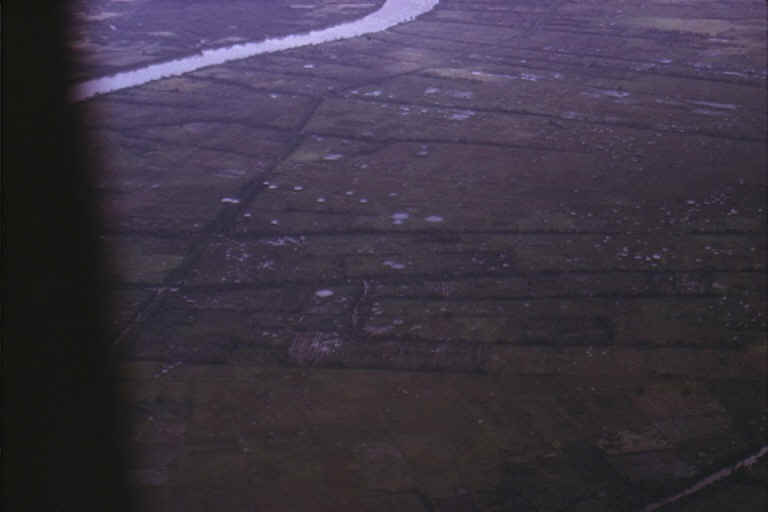

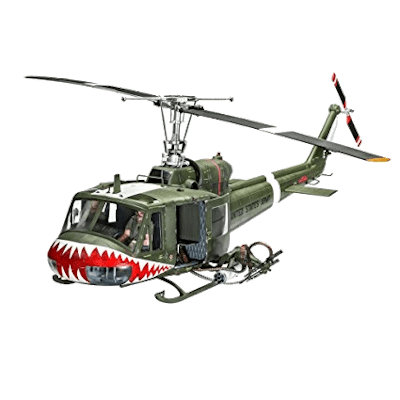
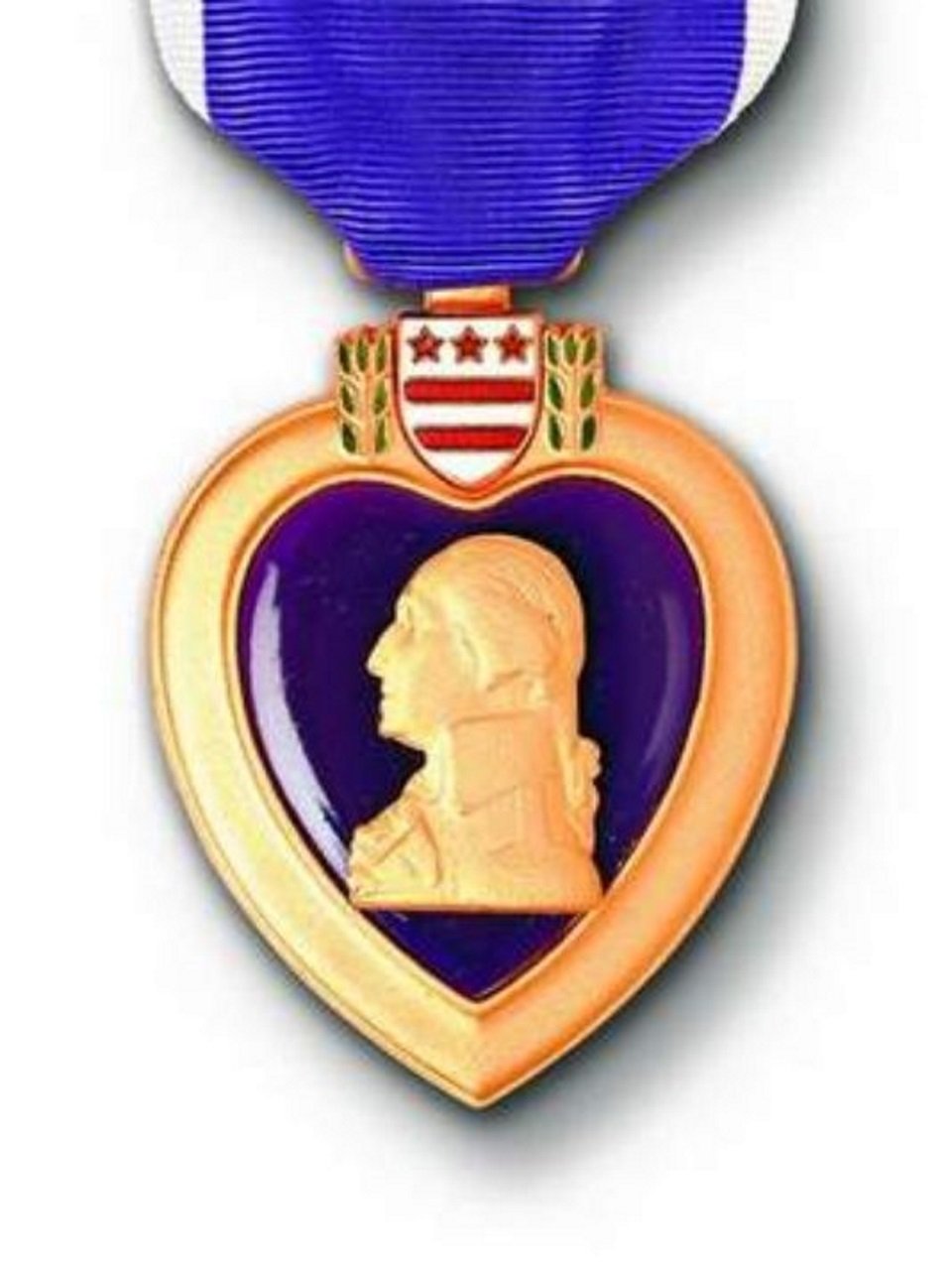
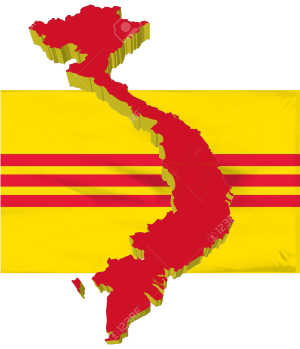
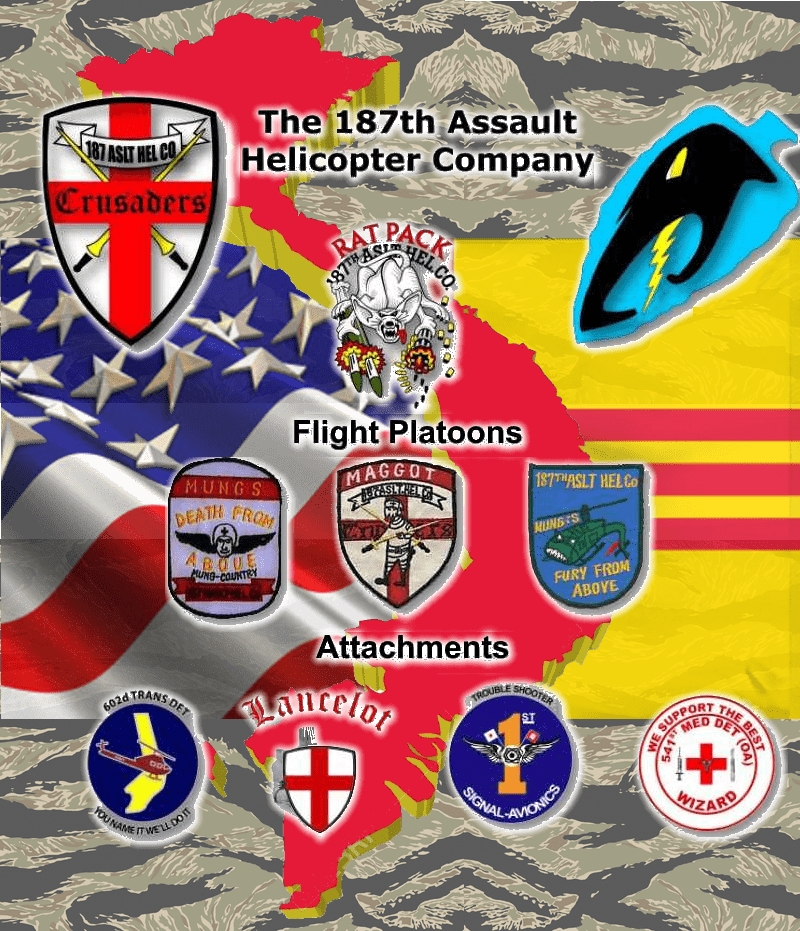
Very good. Your narrative rekindles many memories of that day. The gunship I was in was shot up so badly that after a hot refuel and rearm, we couldn’t take off due to severe vibration. We inspected the ship for damage once the blades stopped turning. The rotor head and dampener rods were hit badly. One rod almost severed completely. That day is forever etched in my mind. Everyone involved was a hero. I left the 187th a month later, being sent to the 190th at Bien Hoa with a few other original members of the company.